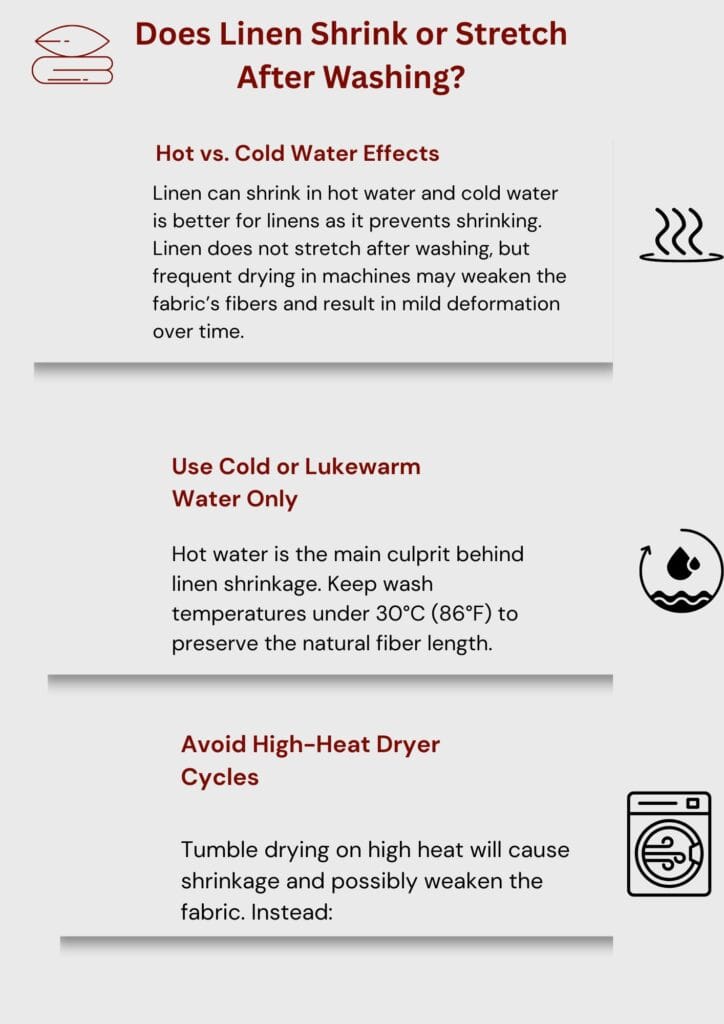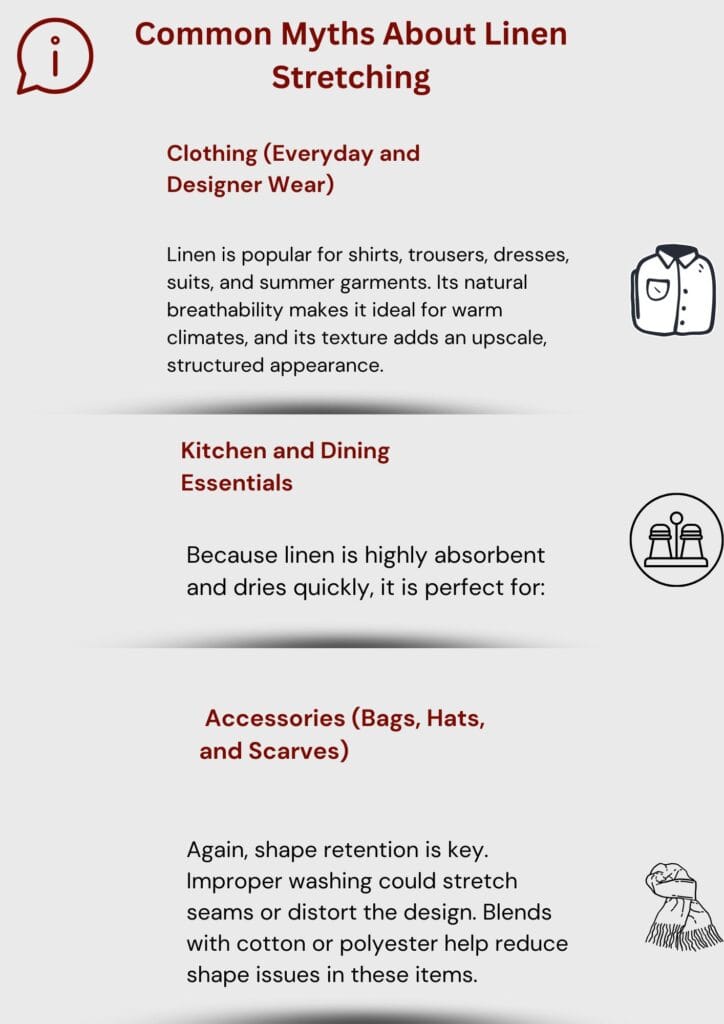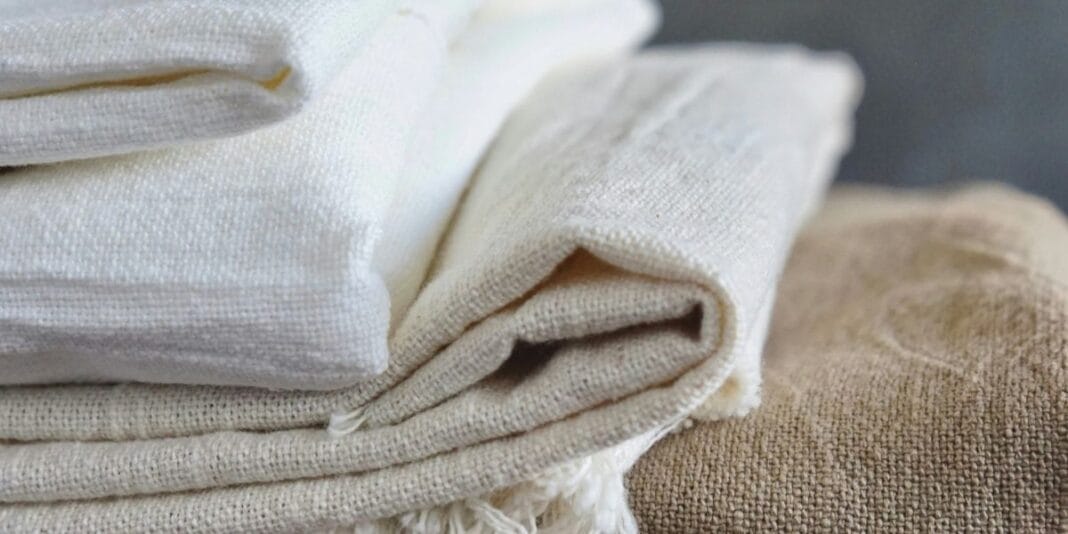Introduction
Linen refers to fabric derived from plants, specifically the flax plant. It is cherished for being breathable, durable, and timeless. Unlike many contemporary fabrics, linen happens to be eco-friendly and quite smooth and crisp in texture. In addition, linen garments ensure comfort since they have superior moisture-wicking capabilities.
But does linen stretch with wear like other fibers? This concern is particular to those fitted linen garments. Since the fabric reacts differently compared to cotton or spandex, it is critical to know how linen behaves with wearing, washing, and water exposure. In this article, we will address the myths around linen’s stretchability and its management.
Does Linen Stretch with Wear?
The General Behavior of Linen Over Time
No, linen does not stretch like cotton or spandex. Rather, it becomes softer to provide a looser fit. Loosening may be noticed in the elbow, knee, and waist regions over time, but this change is brought about by relaxation of the fibres, not permanent stretching.
So, does linen stretch with wear? Not precisely, but it does slightly ease and mould into shape with movement. The responses described above appear over time, and linen’s overall structural integrity remains intact.
Factors Influencing the Stretching of Linen
- Weaving: looser weaves tend to relax more than tighter ones.
- Blends: Linen blended with cotton, rayon or spandex may behave differently in terms of stretch.
- Washing Habits: Aggressive washing or drying may break vulnerable fibers, resulting in a change of shape.
Gentle washing helps fibres maintain the original fit without excessive movement.
Does linen stretch when wet?
The Impact of Water on Linen Fibers
Looking at water’s impact on linen, soaking any linen makes them flexible, which allows for re-shaping wash temporarily expanding and softening the fibers. Linen will revert to its original shape once dry. Hence, even though linen appears to stretch while washing, that is just a part of the process. To answer the question posed earlier, does linen stretch with water? The answer would be yes but temporarily.
Can You Stretch Linen During Washing?
Stretching linens while they’re damp is a bad idea. Weakening lined fibers will cause warping. Linen should be relaxed while wet but shaping should be performed carefully. To preserve the linen’s natural structure, air drying flat is best.
Does Linen Shrink or Stretch After Washing?

Hot vs. Cold Water Effects
Linen can shrink in hot water and cold water is better for linens as it prevents shrinking. Linen does not stretch after washing, but frequent drying in machines may weaken the fabric’s fibers and result in mild deformation over time.
So the answer to does linen stretch or shrink: the answer does depend on temperature when it comes to hot water shrinkage and dryer damage mimic fabric stretching.
How to Prevent Unwanted Stretching or Shrinking
Adhere to these guidelines:
- Use cold water and mild soap for washing.
- Avoid high speed spin cycles.
- Let garments air-dry flat or hang-dry.
- Do not leave garments in the dryer too long.
The prescribed steps enhance shape retention for your linen garments.
How to Stretch Linen Fabric (If Needed)
Methods to Gently Stretch Linen Clothes
Restoring shape seems difficult but with the right techniques you can restore shape and gently relax tight areas:
- Soak item in lukewarm water mixed with baby shampoo or conditioner.
- Gently reshape the item to its original dimensions while laid flat.
- Then roll into a towel to squeeze out excess water.
- Finally release to air-dry flat modifying the shape as needed.
The outlined technique helps fibers relax and enables easy light stretch.
Risk Factors of Fiber Stretching
Take care not to relax tension excessively. Relaxing tension too much can lead to:
- Fiber breakage
- Permanent misshape of garment
- Creation of irrevocable deformities
Excess pressure and ease during wearing anything elasticated will slacken structure so keep it minimal wearing.
Effective Washing and Drying To Preserve Garment Shape
Preservation of Shape Retention of Garments
To maintain the original shape of your linen items:
- Select washing temperatures of cold or lukewarm water.
- Use mesh bags for delicate items.
- Choose air-drying to machine drying.
- Damp ironing helps in shape retention so lightly dampen the garment before ironing.
These practices help ensure enduring quality of your garments made of linen.
Correct Methods for Storing Linen
It is best to keep linen in an dry, cool area. To prevent stretching that heavy linen garments may pull apart, these are effective solutions to consider:
Rather than using closet racks or shelves, use padded hangers when hanging items to prevent overcrowding and fabric strain.
Maintain elongation and strain free conditions by tidily folding garments.
Comparing Fabrics by Types of Stretch: Linen V Other Fabrics
Linen vs cotton, polyester and spandex
The differences in the stretching properties in Linen as compared to other Fabrics is as follows Checkbox from the list below.
- Cotton: Stretches around the bent for P such that component would yield even if P is Soft enough not too thick. And in more pliable and brittle is characteristic of Linen Vs Of Cotton.
- Polyester. Has mechanical stretch due to the synthetic and often fibrous nature of an i.e. Computer Science ci schopenhics, sundices ply.
- Spandex. Stretches farther than any other Fabric; it is used by contiguits “Deps of pants Single Tube sex user Bellows Incredibly Tight Pants.”.
- Linen is a locus if discriminating by limited stretching and lack of materially shortening of a structure.
Blended fabrics are more advantageous if there is a need for flexibility. For a tailored classic fit, linen works best.
Best for Structured vs Flowy Garments
Linen works best for structured garments such as suits, blazers, and trousers as the fabric lends structure give and hold shape. Blended cotton is more appropriate for relaxed flowy dresses and casual wear, or spandex may be better suited.
Common Myths About Linen Stretching

“Does Linen Stretch Like Cotton Does?” – True or false?
False. While both are natural fibers, cotton and linen behave differently. With wear, linen will loosen but does not stretch. For fitted garments, this difference is important.
“All linen blends stretch the same.” – Debunked
Blends do not all behave the same. A linen-spandex blend has greater stretch than a linen-cotton blend. Linen-rayon blends will drape differently but will not stretch much. Always check fabric content before purchase.
Top Suggested Minimal Stretch Linen Blends
Linen-Cotton vs Linen-Rayon vs Linen-Spandex
- Linen-Cotton: Softer and mildly elastic; appropriate for casual shirts and leisurewear.
- Linen-Rayon: Better drape features with very little stretch make this fabric best suited for dresses.
- Linen-Spandex: Gives both stretch and structure; best for skirts and pants that are fitted.
Which is Suitable for Fitted Garments?
Of these, linen-spandex is best. It grants comfort during wear owing to stretch, but looks refined like linen. Pure linen should be avoided for snug styles, unless a bit of surrender over time is tolerable.
Conclusion
So, ends linen up expanding as it’s used? The answer is it relaxes but does not stretch in the conventional sense. While linen does ease with use, it retains its structure far better than most other fabrics. Knowing how washing, water, and even storage affect it is essential in preserving its aesthetics.
FAQs
Moderately, yes. A cold wash followed by a flat air-dry will let the linen fibres recover to some extent. In more serious cases, professional alterations may be required.
Linen might loosen, but denim adapts and stretches much more significantly with wear, as is so often the case with stretchy denims. Spandexed denims, in particular, will outstretch linen far more.
As with stretching of any fabric, tailors do avoid stretchable seam reinforcing and use structured linings, which reinforce the area without adding any excess bulk that could hinder the shape. Tailors also deliberately cut linen in a manner so that it deliberately encourages strain on the critical areas of high stress to avoid “straining” the garment on these areas.


